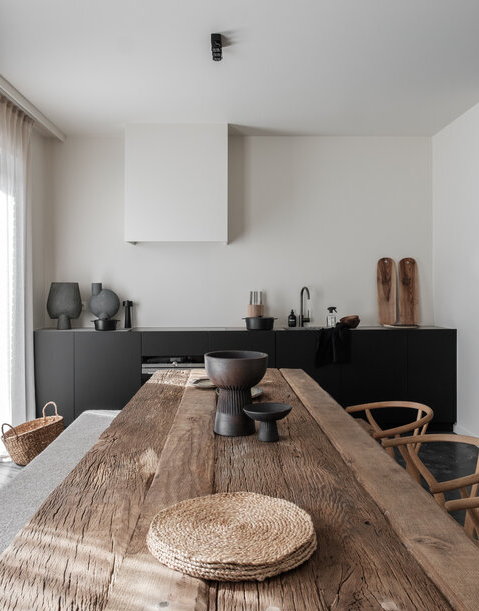Japandi: the perfect balance between Japanese tradition and Scandinavian minimalism
- Kateryna Senko
- Apr 19, 2023
- 4 min read
Updated: Oct 31, 2023
Learn more about the main principles and ideas of Japandi style. Japandi is a design style that combines Japanese minimalism and Scandinavian design. This style appeared not so long ago, but has already become quite popular among designers and fans of minimalist design.



The history Japan+Scandinavia
The history of Japandi began in Europe in 2017 when the Swedish brand IKEA released a line of furniture called "Japandi". This furniture line combined elements of Japanese minimalism and Scandinavian design, and it became very popular among buyers.

Japanese minimalism is not just a design style, it is a whole philosophy of life that has its roots in traditional Japanese culture. The main idea is that life should be simplified in order to achieve maximum comfort and harmony. In Japanese minimalism, adherence to the principle of "less is more" is very important. Simplicity and minimalism are reflected not only in the design, but also in the functionality of things. In Japanese minimalism, each element has its own function and is used as efficiently as possible.
Another important feature of Japanese minimalism is practicality and convenience. Furniture and accessories in Japanese minimalist style have a simple form and ease of use, making them ideal for small spaces and apartments.
The main features of Japanese minimalism include the use of natural materials such as wood, stone, and bamboo, and simple geometric shapes in the design of furniture and decor. The color palette is usually limited to natural shades such as white, gray, brown, and black
Scandi. Its main principles are functionality, simplicity, and natural beauty. Scandinavians believe that design should be simple and understandable, so that people can easily perceive and use it.
Natural materials such as wood, stone, and textiles are used in Scandinavian design. The color palette has natural shades - from white and gray to the natural colors of wood and foliage. Scandinavians prefer minimalism and space, and try to avoid overloaded decor.
The philosophy of Scandinavian design is to create comfortable and functional objects that have a pleasant appearance and can become a part of a person's life. Scandinavian design aims to create simple and understandable solutions for the problems of our everyday lives.

If we compare Scandinavian design to Japanese minimalism, we can note that both styles have common features - both prioritize naturalness and simplicity. They do not strive for luxury and grandeur, but try to emphasize the beauty of nature and natural materials, such as wood, stone, linen fabric, etc. Both styles use geometric shapes and simple lines to create a calm and balanced atmosphere.
Another common element is the use of light and space. In both Japan and Scandinavia, light is important, so windows and transparent surfaces are used for maximum space illumination. Both styles also differ from the usual approach to space utilization - they do not try to fill every corner of the room with furniture and decor, but instead prioritize free space and its maximum utilization.
Overall, both styles have a common philosophy: creating a space that promotes relaxation and harmony, using a minimal amount of elements and emphasizing naturalness and functionality.
Like Japanese minimalism, Scandinavian design does not strive for luxury and opulence but seeks to emphasize the beauty of nature and natural materials.


Some Ukrainian designers who offer furniture in Japandi style are:
FAINA
Faina Design (Файна Дизайн) is a Ukrainian design brand that creates furniture and interior items in the style of contemporary minimalism with elements of Ukrainian tradition. The founder of the brand is Ukrainian designer Faina Lyakhovich, who established the brand in 2014. Faina Design offers collections of furniture, lighting, and decor made from natural materials such as wood, clay, and wool. The brand uses traditional techniques and the craftsmanship of Ukrainian artisans to create unique and functional interior items.

Faina Design
A Ukrainian designer brand that specializes in creating furniture and interior objects using natural materials. They focus on details and carefully study the technologies of working with various materials to create unique and exclusive products. The products stand out for their sophisticated design and minimalist style, which allows them to fit perfectly into the concept of Japanese tradition and Scandinavian minimalism.

Makhno Design
A Ukrainian designer brand that creates furniture and interior items using local materials and traditional production techniques. Their goal is to combine contemporary design with Ukrainian culture and develop products that reflect modern interior design trends.

KONONENKO ID
The studio specializes in creating interior items and lighting in the aesthetics of modernism, art deco, and Bauhaus. In their works, the designer uses both the restoration of historical styles and their modern interpretation, embodying the idea of harmony between design and functionality. In addition, the studio also collaborates with Ukrainian manufacturers, ensuring high quality and attention to detail in each of their products.
Лампи Zori, дизайн Senko Architects
Ukrainian furniture brand that works with natural materials and traditional techniques. The company creates furniture that stands out for its high quality and unique design. STARITSKA MAYSTERNYA products are handmade in Ukraine by craftsmen with years of experience in the furniture manufacturing industry.






















